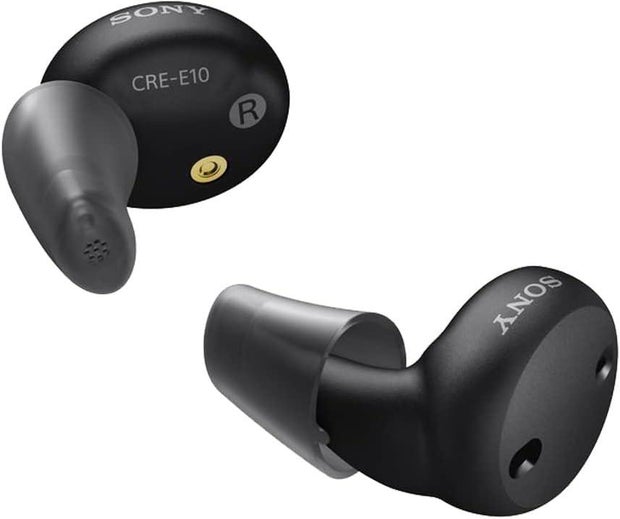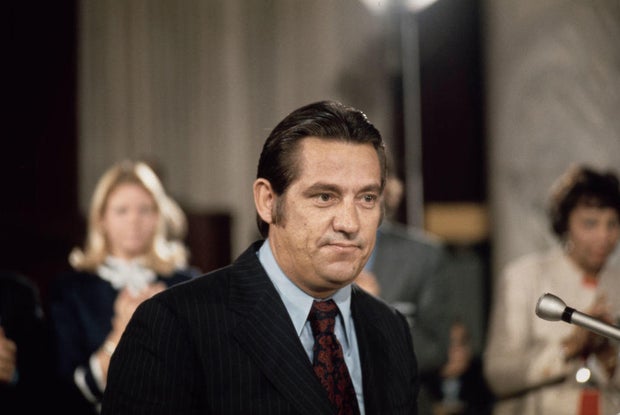CBS News
Best hearing aids for seniors in 2024

LightFieldStudios via Getty Images
Hearing loss can affect adults of any age, but it’s not uncommon for this condition to grow worse over time. Age-related hearing loss can be a problem for around one in three people over 65, and by the time you reach 75, that number jumps to roughly 50%. Don’t wait until the issue gets out of hand: schedule an appointment with your doctor to discuss whether hearing aids are right for you, then check out our top picks below for the best hearing aids for older adults.
You deserve a hearing aid that works for you, combating mild to profound hearing loss effectively while making life better thanks to rich audio features and easy instructions for everyday use. That means no medical devices with subpar sound amplification or poor usability.
Your doctor, as well as a trusted audiologist or hearing specialist will help you understand the extent of your hearing loss and settle on a hearing aid that can help. Check out the best hearing aids for seniors in 2024 below now to learn which brands and devices you may want to consider.
What is the best hearing aid for seniors?
Looking at both prescription and over-the-counter (OTC) hearing aids, we considered factors like a simple user-friendly design, good sound technology and affordability to find the absolute best hearing aids for older adults.
Prices listed for prescription hearing aids may differ from what you see when discussing hearing aids with your care team. That’s because different factors can affect costs such as charges for a professional fitting and programming services to get you all set up. Our prescription-grade hearing aid prices are calculated based on data from different healthcare providers and customer accounts.
Our top pick: Jabra Enhance Plus
Jabra
The first OTC hearing aid from Jabra, the Enhance Plus is a tiny device that could pass for a pair of wireless earbuds at first glance. This design offers a sleek, almost invisible look that won’t stand out.
The best features for this hearing aid include a long battery life (10-plus hours per charge), great speech amplification, and a lower price point than most prescription hearing aids.
Prices start at $799 for the Jabra Enhance Plus hearing aids.
Pros:
- Easy set-up and maintenance using the Jabra Enhance app.
- Great battery life.
- Nice balance of affordability and accessibility, making these our pick for best OTC hearing aids.
Cons:
- Jabra mobile app is currently only available for iOS.
- Sound quality and background noise cancellation features could be better.
Best for moderate to severe hearing loss: Phonak Audéo Lumity
Phonak
This hearing aid has several new and impressive features over previous Phonak hearing aids, such as improved tech that can focus on nearby voices: StereoZoom boosts front-facing conversations, while SpeechSensor makes it easier to hear voices from people to your side or even behind your back.
This hearing aid also offers Bluetooth connectivity for both iOS and Android devices and fitness-tracking features like step counts. If you’re interested in controlling your hearing aid from your phone, the mobile Phonak app makes everyday adjustments a breeze.
As a prescription hearing aid, the Phonak Lumity is available in four technology tiers, with more functionalities (and a higher price) tied to higher ones. These include L30 (essential), L50 (standard), L70 (advanced), and L90 (premium).
Prices start at around $1,800 for the lowest tier, the Lumity L30 hearing aid.
Pros:
- High-quality sound amplification from a trusted hearing aid brand.
- Multiple tech tiers can make it easy to find the right device for your needs (and your budget).
- Mobile app compatibility with iOS and Android devices.
Cons:
- MyPhonak app has conflicting reviews about user friendliness.
- Choosing the right tech tier can be overwhelming — consult with your audiologist to find the right fit for you.
Most affordable: Audien Hearing Atom 2
Audien Hearing
If you want quality hearing aids from the most budget-friendly hearing aid brand, look no further than the Atom 2 hearing aids by Audien Hearing.
This small and discreet hearing aid can be just as useful for people with severe hearing loss as they are for those with mild to moderate hearing loss. The Atom 2 by Audien Hearing also offers solid background noise cancellation.
Don’t just take our word for it — according to Audien Hearing, this hearing aid currently holds a 4.5 out of five star rating with more than 500,000 customer reviews.
These budget-friendly hearing aids are available for just $189 at Audien Hearing below.
Pros:
- The absolute lowest price you’re going to find for high quality OTC hearing aids from a trusted and budget-friendly hearing aid brand.
- Multiple preset programs can make these a great pick for people with varying degrees of hearing loss, as well as anyone with the inner ear disorder Ménière disease, which can require multiple adjustments throughout the day.
- 24-hour battery life on a single charge.
Cons:
- Small size and sleek design can make these difficult to maneuver or configure for older adults.
- Sound amplification and background cancellation features aren’t as crisp or robust as other, pricier models.
Best sound quality: Sony CRE-E10
Sony
Whether you’re trying to listen to music, focus on a nearby conversation or simply relax along with the ambient sounds of everyday life, crisp sound quality is important. This hearing aid offers that and more, such as speech enhancement and feedback reduction at a quality to rival many prescription hearing aids.
If you want a premium hearing aid that you can fit yourself with perks like Bluetooth connectivity and an exceptional battery life, this is the hearing aid for you.
One caveat: You will have to deal with a price tag closer to prescription hearing aids versus your average OTC device, as the CRE-E10 is normally available for $1,299.
Pros:
- Exceptional sound quality for OTC hearing aids.
- With a battery life clocking in at more than 25 hours per charge according to Sony, these hearing aids are the longest-lasting devices on this list.
Cons:
- Higher price than most OTC hearing aids.
- Although there are automatic adjustments that kick in based on your environment, there are no touch controls or physical buttons — all adjustments can be made via a mobile app, which can take some getting used to.
Best for hands-free phone calls and wireless streaming: Go Hearing ultra
Go Hearing
This behind-the-ear OTC hearing aid comes with several standout features, such as Bluetooth streaming capability, hands-free calls, and a whopping 20-hour battery life, that make it a great tool for older adults tired of having to manually handle their hearing aid every so often.
Thanks to its flexibility and included measuring tool, this hearing aid is easily fitted and configured on your own — no visits to an audiologist or specialist required if you’d prefer to get situated from the comfort of home.
Pros:
- Comfortable and lightweight, especially for behind-the-ear hearing aids, which can sometimes be on the bulkier side.
- Impressive battery life for OTC hearing aids.
Cons:
- Sound performance isn’t as impressive as other hearing aids.
- No mobile app, so adjustments are limited to the device’s buttons.
What are the different hearing aid styles?
The sheer variety of hearing aid styles and models can be overwhelming for people of any age, let alone seniors hoping for a quick and easy recommendation from their doctor.
There are smaller devices that make for a less noticeable look, while slightly bulkier hearing aids have parts that sit comfortably behind and around the ear. Go to your next audiologist appointment prepared by knowing the most common styles you might come across, including:
- Behind-the-ear (BTE): BTE hearing aids loop over the top of the ear, with most of the electronics in a plastic case behind it. With the largest design, these provide optimal sound amplification over other models.
- Receiver-in-the-canal (RIC): RIC hearing aids (as well as the smaller receiver-in-the-ear, or RITE, devices) are similar to a BTE in design, but with a connecting wire in place of the BTE’s earmold. This gives the ear canal more room and results in a more comfortable fit.
- In-the-ear (ITE): ITE hearing aids are custom-made to sit entirely in the outer ear. These devices have a longer battery life and usually come with more features, such as volume control, than smaller models.
- Completely-in-the-canal (CIC): CIC hearing aids have the smallest design, with a custom-built shell that fits in the ear canal. These are the least noticeable, but don’t offer many features or the most powerful sound amplification.
- Open fit: A variation of a BTE, an open-fit hearing aid has an over-the-ear design with an open dome in the canal instead of a tube or mold. This keeps the ear canal open for natural sound to enter the ear as well – ideal for mild to moderate hearing loss.
How much do hearing aids cost?
When it comes to hearing aid prices, there are two groups to consider: prescription hearing aids and over-the-counter, or OTC hearing aids.
One 2018 survey of over 2,000 adults found that the average price for high quality prescription hearing aids cost around $4,600 — with the caveat that prices range widely for a number of reasons and can be anywhere from $1,000 to more than $8,000 per pair.
OTC hearing aids are a relatively new category where customers can get their hands on decent devices for much lower costs — less than $1,000 a pair. These typically come with less robust tech features (making them ideal for people with mild to moderate hearing loss) and none of the complex extras that you get with a prescription hearing aid.
Can hearing aids help with tinnitus?
Tinnitus is an auditory issue where one perceives persistent or intermittent sounds (such as a ringing, roaring or buzzing) that don’t have a real outside source. While they don’t cure or reduce the severity of tinnitus, hearing aids are considered by experts like those at the National Council on Aging (NCOA) to be a leading treatment option for relief from tinnitus.
The best hearing aids for tinnitus can help you manage frustrating or distracting symptoms, thanks to features like customizable hearing programs and advanced sound-processing capabilities. Some quality hearing aids can effectively mask the persistent sounds that come with tinnitus, distracting users from the most persistent symptoms of tinnitus.
Some prescription-grade hearing aids let users fine-tune sound settings on the fly, which is ideal for dealing with tinnitus symptoms that come and go or change in severity over time.
How we chose the best senior-friendly hearing aids of 2024
For a closer look at how we rate products, here is what we prioritized while putting together our list of the best hearing aids you can buy today:
- Usability: Hearing aids for seniors should be easy to put in and take out. Cleaning and making daily adjustments should be easy, as well. We stuck with senior-friendly hearing aids that meet these requirements.
- Comfortability: We paid attention to the design, shape, and fit of each hearing aid to ensure only the most comfortable hearing aids made the list.
- Affordability: We looked at both prescription hearing aids and the more budget-friendly OTC devices to make sure we highlight high quality hearing aids of all price points.
- Customer reviews: All of our hearing devices hold a four-star review or higher from happy customers just like you.
CBS News
2 killed in U.S. Civil Air Patrol plane crash near Palisade Mountain in Northern Colorado

Two people were killed and a third was injured when a U.S. Civil Air Patrol plane crashed in Colorado’s Front Range Saturday morning.
The small passenger plane with three people aboard crashed near Storm Mountain and Palisade Mountain west of Loveland around 11:15 a.m., according to the Larimer County Sheriff’s Office. The plane belonged to the Civil Air Patrol, the civilian auxiliary wing of the U.S. Air Force, and was on a routine aerial photography training mission when it went down, officials said.
Pilot Susan Wolber and aerial photographer Jay Rhoten were identified by CAP as those killed and co-pilot Randall Settergren was identified as the person injured. Settergren was airlifted to an area hospital by a National Guard helicopter, where he is undergoing medical care.
CBS
“The volunteers of Civil Air Patrol are a valuable part of the Department of Military and Veterans Affairs, and the lifesaving work they do on a daily basis directly contributes to the public safety of Coloradans throughout the state,” Maj. Gen. Laura Clellan, adjutant general of the Colorado Department of Military and Veterans Affairs, said in a statement Saturday.
“We are devastated to hear of the loss of Susan Wolber and Jay Rhoten, and the injury of Randall Settergren, during a training mission in Larimer County. Our thoughts and deepest condolences are with the families of those involved in the crash,” Clellan continued. “I would also like to thank all of the first responders who assisted with rescue efforts.”
Palisade Mountain is in Larimer County, about 20 miles west of Loveland and about 65 miles northwest of Denver. The area is part of the burn scar of the Alexander Mountain Fire, which burned almost 10,000 acres in over two weeks this past summer.
The crash happened about 200 feet below the summit of Palisade Mountain in an area that includes tall trees and steep hills as part of the mountain range. Rescue crews were heard on radio traffic working to find a landing zone for rescue helicopters. No structures were impacted by the crash.
The plane crashed in “very rugged” and “extensive and rocky terrain,” Ali Adams, a Larimer County Sheriff’s Office spokeswoman, said at a news conference. First responders had to hike out to the site and the sole survivor was “severely injured” when responders finally got to them.
Rescue efforts were ongoing at 3:15 p.m., according to Adams, and recovery efforts for the two deceased people’s bodies could take several days.
Several agencies responded, including the Loveland Fire Rescue Authority, Thompson Valley EMS and the National Guard.
The Larimer County Sheriff’s Office is the lead agency investigating the crash and the Federal Aviation Administration and National Transportation Safety Board will assist, according to Adams. The NTSB said it too was investigating the crash and identified the plane as a Cessna 182.
“This is one of those incidents that is really low frequency; it doesn’t happen really often, but unfortunately, our first responders have had more than their fair share of responses,” Adams said.
George Solheim lives in the area of the crash. He described conditions as “extremely windy” on Saturday and heard the plane just prior to the crash. He says he could hear “loud ‘throttle up/down’ immediately prior to sudden silence at (the) time of (the) crash. Couldn’t hear sounds of impact from here.”
Colorado Gov. Jared Polis extended his sympathy to the families of the victims in a statement Saturday evening:
“I’m saddened to hear of the loss of two dedicated Civil Air Patrol members, Pilot Susan Wolber and aerial photographer Jay Rhoten, who lost their lives in today’s crash and my thoughts are with their families, friends and colleagues. These individuals, along with survivor co-pilot Randall Settergren, who was injured, served the Civil Air Patrol as volunteers who wanted to help make Colorado a better, safer place for all. The State of Colorado is grateful for their commitment to service and it will not be forgotten. I also want to thank the first responders who assisted with the rescue and recovery efforts.”
CBS News
Fred Harris, former Democratic U.S. senator and presidential candidate, dies at 94

Fred Harris, a former U.S. senator from Oklahoma, presidential hopeful and populist who championed Democratic Party reforms in the turbulent 1960s, died Saturday. He was 94.
Harris’ wife, Margaret Elliston, confirmed his death to The Associated Press. He had lived in New Mexico since 1976.
“Fred Harris passed peacefully early this morning of natural causes. He was 94. He was a wonderful and beloved man. His memory is a blessing,” Elliston said in a text message.
Bettmann Archive/Getty Images
Harris served eight years in the Senate, first winning in 1964 to fill a vacancy, and made unsuccessful bid for the presidency in 1976.
“I am deeply saddened to learn of the passing of my longtime friend Fred Harris today,” Democratic New Mexico Gov. Michelle Lujan Grisham wrote in a post to social media. “Harris was a towering presence in politics and in academia, and his work over many decades improved New Mexico and the nation. He will be greatly missed.”
Democratic Sen. Martin Heinrich of New Mexico said in a statement that “New Mexico and our nation have lost a giant,” describing him as a “tireless champion of civil rights, tribal sovereignty and working families.”
It fell to Harris, as chairman of the Democratic National Committee in 1969 and 1970, to help heal the party’s wounds from the tumultuous national convention in 1968 when protesters and police clashed in Chicago.
He ushered in rule changes that led to more women and minorities as convention delegates and in leadership positions.
“I think it’s worked wonderfully,” Harris recalled in 2004, when he was a delegate to the Democratic National Convention in Boston. “It’s made the selection much more legitimate and democratic.”
“The Democratic Party was not democratic, and many of the delegations were pretty much boss-controlled or -dominated. And in the South, there was terrible discrimination against African Americans,” he said.
Harris ran unsuccessfully for the Democratic presidential nomination in 1976, quitting after poor showings in early contests, including a fourth-place win in New Hampshire. The more moderate Jimmy Carter went on to win the presidency.
Harris moved to New Mexico that year and became a political science professor at the University of New Mexico. He wrote and edited more than a dozen books, mostly on politics and Congress. In 1999 he broadened his writings with a mystery set in Depression-era Oklahoma.
Throughout his political career, Harris was a leading liberal voice for civil rights and anti-poverty programs to help minorities and the disadvantaged. Along with his first wife, LaDonna, a Comanche, he also was active in Native American issues.
“I’ve always called myself a populist or progressive,” Harris said in a 1998 interview. “I’m against concentrated power. I don’t like the power of money in politics. I think we ought to have programs for the middle class and working class.”
“Today ‘populism’ is often a dirty word because of how certain leaders wield power,” Heinrich said in his statement Saturday. “But Fred represented a different brand of populism — one that was never mean or exclusionary. Instead, Fred focused his work and attention on regular people who are often overlooked by the political class.”
Harris was a member of the National Advisory Commission on Civil Disorders, the so-called Kerner Commission, appointed by then-President Lyndon Johnson to investigate the urban riots of the late 1960s.
The commission’s groundbreaking report in 1968 declared, “our nation is moving toward two societies, one black, one white — separate and unequal.”
Thirty years later, Harris co-wrote a report that concluded the commission’s “prophecy has come to pass.”
“The rich are getting richer, the poor are getting poorer and minorities are suffering disproportionately,” said the report by Harris and Lynn A. Curtis, president of the Milton S. Eisenhower Foundation, which continued the work of the commission.
Norman Ornstein of the American Enterprise Institute said Harris rose to prominence in Congress as a “fiery populist.”
“That resonates with people…the notion of the average person against the elite,” Ornstein said. “Fred Harris had a real ability to articulate those concerns, particularly of the downtrodden.”
In 1968, Harris served as co-chairman of the presidential campaign of then-Vice President Hubert Humphrey. He and others pressed Humphrey to use the convention to break with Johnson on the Vietnam War. But Humphrey waited to do so until late in the campaign, and narrowly lost to Republican Richard Nixon.
“That was the worst year of my life, ’68. We had Dr. Martin Luther King killed. We had my Senate seatmate Robert Kennedy killed and then we had this terrible convention,” Harris said in 1996.
“I left the convention — because of the terrible disorders and the way they had been handled and the failure to adopt a new peace platform — really downhearted.”
After assuming the Democratic Party leadership post, Harris appointed commissions that recommended reforms in the procedures for selecting delegates and presidential nominees. While lauding the greater openness and diversity, he said there had been a side effect: “It’s much to the good. But the one result of it is that conventions today are ratifying conventions. So it’s hard to make them interesting.”
“My own thought is they ought to be shortened to a couple of days. But they are still worth having, I think, as a way to adopt a platform, as a kind of pep rally, as a way to get people together in a kind of coalition-building,” he said.
Harris was born Nov. 13, 1930, in a two-room farmhouse near Walters, in southwestern Oklahoma, about 15 miles from the Texas line. The home had no electricity, indoor toilet or running water.
At age 5 he was working on the farm and received 10 cents a day to drive a horse in circles to supply power for a hay bailer.
He worked part-time as a janitor and printer’s assistant to help for his education at University of Oklahoma. He earned a bachelor’s degree in 1952, majoring in political science and history. He received a law degree from the University of Oklahoma in 1954, and then moved to Lawton to practice.
In 1956, he won election to the Oklahoma state Senate and served for eight years. In 1964, he launched his career in national politics in the race to replace Sen. Robert S. Kerr, who died in January 1963.
Harris won the Democratic nomination in a runoff election against J. Howard Edmondson, who left the governorship to fill Kerr’s vacancy until the next election. In the general election, Harris defeated an Oklahoma sports legend — Charles “Bud” Wilkinson, who had coached OU football for 17 years.
Harris won a six-year term in 1966 but left the Senate in 1972 when there were doubts that he, as a left-leaning Democrat, could win reelection.
Harris married his high school sweetheart, LaDonna Vita Crawford, in 1949, and had three children, Kathryn, Byron and Laura. After the couple divorced, Harris married Margaret Elliston in 1983. A complete list of survivors was not immediately available Saturday.
CBS News
Compromise deal reached at COP29 climate talks for $300 billion a year to poor nations

Countries agreed on a deal to inject at least $300 billion annually in humanity’s fight against climate change, aimed at helping poor nations cope with the ravages of global warming at tense United Nations climate talks in the city where industry first tapped oil.
The $300 billion will go to developing countries who need the cash to wean themselves off the coal, oil and gas that causes the globe to overheat, adapt to future warming and pay for the damage caused by climate change’s extreme weather. It’s not near the full amount of $1.3 trillion that developing countries were asking for, but it’s three times the $100 billion a year deal from 2009 that is expiring. Delegations said this deal is headed in the right direction, with hopes that more money flows in the future.
“Everybody is committed to having an agreement,” Fiji delegation chief Biman Prasad said as the deal was being finalized. “They are not necessarily happy about everything, but the bottom line is everybody wants a good agreement.”
It’s also a critical step toward helping countries on the receiving end create more ambitious targets to limit or cut emissions of heat-trapping gases that are due early next year. It’s part of the plan to keep cutting pollution with new targets every five years, which the world agreed to at the U.N. talks in Paris in 2015.
The Paris agreement set the system of regular ratcheting up climate fighting ambition as away to keep warming under 1.5 degrees Celsius above pre-industrial levels. The world is already at 1.3 degrees Celsius and carbon emissions keep rising.
Countries also anticipate that this deal will send signals that help drive funding from other sources, like multilateral development banks and private sources. That was always part of the discussion at these talks — rich countries didn’t think it was realistic to only rely on public funding sources — but poor countries worried that if the money came in loans instead of grants, it would send them sliding further backward into debt that they already struggle with.
“The $300 billion goal is not enough, but is an important down payment toward a safer, more equitable future,” said World Resources Institute President Ani Dasgupta. “This deal gets us off the starting block. Now the race is on to raise much more climate finance from a range of public and private sources, putting the whole financial system to work behind developing countries’ transitions.”
It’s more than the $250 billion that was on the table in the first draft of the text, which outraged many countries and led to a period of frustration and stalling over the final hours of the summit. After an initial proposal of $250 billion a year was soundly rejected, the Azerbaijan presidency brewed up a new rough draft of $300 billion, that was never formally presented, but also dismissed roundly by African nations and small island states, according to messages relayed from inside.
The several different texts adopted early Sunday morning included a vague but not specific reference to last year’s Global Stocktake approved in Dubai. Last year there was a battle about first-of-its-kind language on getting rid of the oil, coal and natural gas, but instead it called for a transition away from fossil fuels. The latest talks only referred to the Dubai deal, but did not explicitly repeat the call for a transition away from fossil fuels.
Countries also agreed on the adoption of Article 6, creating markets to trade carbon pollution rights, an idea that was set up as part of the 2015 Paris Agreement to help nations work together to reduce climate-causing pollution. Part of that was a system of carbon credits, allowing nations to put planet-warming gasses in the air if they offset emissions elsewhere. Supporters said a U.N.-backed market could generate up to an additional $250 billion a year in climate financial aid.
Despite its approval, carbon markets remain a contentious plan because many experts say the new rules adopted don’t prevent misuse, don’t work and give big polluters an excuse to continue spewing emissions.
“What they’ve done essentially is undermine the mandate to try to reach 1.5,” said Tamara Gilbertson, climate justice program coordinator with the Indigenous Environmental Network. Greenpeace’s An Lambrechts, called it a “climate scam” with many loopholes.
With this deal wrapped up as crews dismantle the temporary venue, many have eyes on next year’s climate talks in Belem, Brazil.









